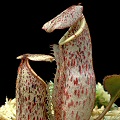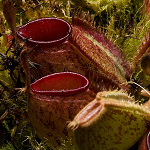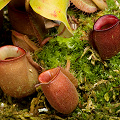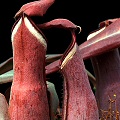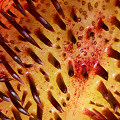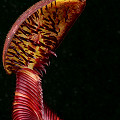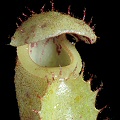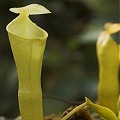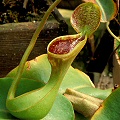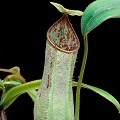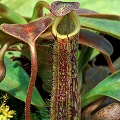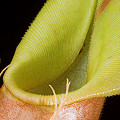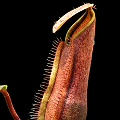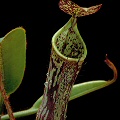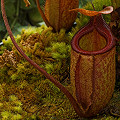| Bornean species | |
|---|---|
| Lowlanders | Highlanders |
|
N. bicalcarata N. campanulata N. clipeata N. hemsleyana N. hispida N. mapuluensis N. northiana |
N. appendiculata N. boschiana N. burbidgeae N. chaniana9 N. edwardsiana N. ephippiata N. glandulifera N. hurrelliana N. lowii N. macrophylla N. mollis N. muluensis N. murudensis10 N. pilosa N. rajah N. villosa N. vogelii |
| Highland-lowland | |
|
N. albomarginata1 N. ampullaria2 N. epiphytica N. faizaliana N. fallax7 N. fusca N. gracilis3 N. hirsuta N. macrovulgaris N. mirabilis4 N. platychila N. rafflesiana5 N. reinwardtiana6 N. stenophylla7 N. tentaculata8 N. veitchii |
|
|
1Also in Peninsular Malaysia, Sumatra. 2Also in Maluku, New Guinea, Peninsular Malaysia, Singapore, Sumatra, Thailand. 3Also in Peninsular Malaysia, Singapore, Sulawesi, Sumatra, Thailand. 4Also in Australia, China, Hong Kong, Indo-China, Java, Macau, Maluku, New Guinea, Palau, Peninsular Malaysia, Philippines, Sulawesi, Sumatra, Thailand. 5Also in Peninsular Malaysia, Singapore, Sumatra. 6Also in Sumatra. 7These are sometimes folded into N. stenophylla. 8Also in Sulawesi. 9Clarke, C. et al. 2006. 10Probably of hybrid origin, N. tentaculata × reinwardtiana. |
|
Q: Nepenthes: species of Borneo
A: Borneo is a large island in Southeast Asia. Indeed, with a surface area of about
750,000 km2, it is the third largest island in the world (exceeded only by Greenland and New Guinea).
Most of Borneo is lowland habitat, but its highest point is
Mount Kinabalu (4100 m), near Borneo's northern tip. This mountain, more than any other place in the world, is associated indelibly
with Nepenthes pitcher plants. Important vegetation types in Borneo include lowland rain forests,
lowland peat swamp forests, heath forests (called keranga), montain rain forests, and alpine meadows.
Borneo contains some of the world's oldest rainforests, and the lack of major disturbance has given life time to evolve into
bewildering forms. Estimates place the number of flowering plants in Borneo at 15,000, with many being endemic.
The southern two-thirds of Borneo is called Kalimantan and is owned by Indonesia. Kalimantan comprises four states: Kalimantan Barat
(west Kalimantan), Kalimantan Tengah (central Kalimantan), Kalimantan Selatan (south Kalimantan), and
Kalimantan Timur (east Kalimantan).
The northern third of Borneo, along the coast, is primarily owned by Malaysia. The two Malaysian states are Sarawak (north-northwest coast)
and Sabah (the northeastern most tip of Borneo). It is Sabah that contains Mt. Kinabalu.
Set within Sarawak are two separate chunks of coastal land which together (6000 km2) comprise the extremely wealthy,
tiny sultanate of Brunei Darussalam. Brunei's wealth is heavily based in crude oil and natural gas production.
Borneo is rapidly becoming deforested, as timber production--especially for plywood--is a major component of its economy.
The years 1997 and 1998 were very bad for Borneo when human-started forest fires
burned a great deal of the rainforest during heavy droughts. As another source of conservation pressure,
tourism is also strong in Borneo. It is a test case to see how well the Bornean governments balance
protecting the native biodiversity against the stresses that can be introduced by ecotourism.
Incidentally, Mount Kinabalu aside, the names of most mountains in Borneo carry the leading word, "Gunung." This is
equivalent to "Mountain."
So for example, you might note that "Nepenthes clipeata lives on Gunung Kelam," but you
would not refer to the pitcher plant's home as "Mt. Gunung
Kelam." That would be as redundant as referring to an "ATM machine."
It would be foolish for me to try to describe in detail all the different Nepenthes of Borneo.
Instead, I will provide a highly idiosyncratic set of comments about a few of the species below. Those who are interested in
these species would be fools to not read the books written by Charles Clarke and Stew McPherson.
Nepenthes albomarginata
The white band on this plant's pitcher (hence the Latin name) apparently serves to
attract termites. This species just loooooves termites. The common form is green, rarer forms have red or
blackish pitchers.
Nepenthes ampullaria
The lid of this plant does not shield the pitcher from rain, but this is for the best because
the plant apparently enjoys eating dead leaves and twigs nearly as much as it does insects. The common form is green, but
green with red blotches, red with green blotches, or all-red forms are known. The cultivar 'Cantley's Red' is particularly
pretty.
Nepenthes bicalcarata
Famous for the toothlike nectaries that hang above the pitcher mouth, this species produces
hollow tendrils that serve as homes for ants (Camponotus schmitzi). The ants return the favor by attacking
weevils (Alcidodes sp.)that might damage the developing
leaf tendrils. Lower pitchers range green to red, upper pitchers are usually yellowish or orange,
sometimes green.
Nepenthes boschiana
A source of confusion and controversy, considered by Clarke (1997) to include
"N. borneensis", although Jebb & Cheek (1997) do not agree. Using the Clarke
perspective of the species, it is found only on the top ridges of Gunung Besar.
Nepenthes burbidgeae
A beautifully spotted plant with a nearly white base color. Its distribution is restricted
to ultramafic sites on Mount Kinabalu and Mount Tambuyukon.
Nepenthes campanulata
Once thought to be extinct when its only known site was destroyed, a new site
(undisclosed) was subsequently found. This strange little species has essentially no peristome. Reported also from the Philippines, but without sufficient
documentation.
Nepenthes chaniana
A very hairy, yellowish species found in Sabah.
Nepenthes clipeata
Found only on the
granite cliffs of Gunung Kelam, likely to become extinct because of poaching and fire aided by climate changes.
Nepenthes edwardsiana
I think this is the most beautiful species, because of the ornate peristome.
Like N. burbidgeae, found only on Mount Kinabalu and Mount Tambuyukon.
Nepenthes ephippiata
It must be said---this is a grotesque species that creeps me out because the weird
lid looks like some diseased internal animal organ. See it and you'll understand. It is known form Bukit Raya and Bukit Lesung,
and is probabably elsewhere.
Nepenthes faizaliana
Closely related to N. boschiana and
N. stenophylla (and a source of taxonomic controversy). Restricted to limestone mountains of
Gunung Mulu in Sarawak.
Nepenthes fusca
Wide-ranging in Borneo, but almost always epiphytic and difficult to see.
Nepenthes glandulifera
Similar to N. pilosa, and endemic to the Hose
Mountains of Sarawak.
Nepenthes gracilis
A relatively tiny species, quite forgiving of cultivation errors and an excellent choice for the
terrarium grower.
Nepenthes hemsleyana
Formerly known as Nepenthes rafflesiana var.
elongata, and then Nepenthes baramensis. This species is remarkable for adaptations that might encourage it as a roosting site for a
species of bat (Kerivoula hardwickii).
Nepenthes hirsuta
A green, not particularly showy species, distributed throughout western Borno.
Nepenthes hispida
A species similar to N. hirsuta, and whether these two should
be considered separate species is controversial. The nature of the stem hairs is the most reliable character. Found in Sarawak
and Brunei.
Nepenthes hurrelliana
Possibly a species that was derived from a stabilized hybridization between
N. fusca and N. veitchii. Found in Sarawak, Brunei, and Sabah.
Nepenthes lowii
A plant which produces upper pitchers that apparently capture bird excrement. Yum yum!
Found on a number of Bornean mountains.
Nepenthes macrophylla
A very beautiful plant.
Adopting the perspective of Charles Clarke for this species, it is found only at the
summit of Mount Trus Madi (Sabah), although it might be elsewhere.
Nepenthes macrovulgaris
A plant with chunky but somewhat nondescript pitchers.
Found on Mount Silam, Mount Kinabalu, and Mount Nambuyukon.
Nepenthes mapuluensis
Originally thought to be only from Gunung Ilas Mapulu (Kalimantan Timur), it
apparently occurs in other locations as well.
Nepenthes mirabilis
The most widely ranging species in the genus, usually with flimsy leaves. The bizarre
N. mirabilis var. echinostoma grows in Brunei and Sarawak, and is
distinctive because of its broad, flat peristome that looks like a hormone-induced tissue culture mutant.
Nepenthes mollis
A plant known only from a single, pitcherless herbarium collection made in 1925 from
Gunung Kemal.
Nepenthes muluensis
Similar to N. tentaculata, and easily distinguished only
by the upper pitchers. Found on Gunung Mulu, Gunung Murud, and Bukit Batu Lawi.
Nepenthes murudensis
Perhaps a stabilized hybrid swarm, found on the summit of Gunung Murud.
Nepenthes northiana
Known only from the limestone hills south of Kuching.
Nepenthes pilosa
A green, epiphytic plant that seems restricted to central Borneo.
Nepenthes platychila
Restricted to the Hose Mountains in central Borneo; a plant with a smooth
peristome.
Nepenthes rafflesiana
Remarkable for the enormous variety of pitcher types. In 2011, the very elongated
forms (var. elongata) were pulled out into the newer species Nepenthes hemsleyana.
Nepenthes rajah
Famous for some of the largest-volume pitchers in the genus, which look enormously like
toilet bowls, complete with a seat and lid. Found only on Mount Kinabalu and Mount Tambuyukon.
Nepenthes reinwardiana
A plant with red or green pitchers, with white interiors. The
plant often (but not always) has a pair of strange little eye-spots in each pitcher. Why, oh why?
(This character is shared, incidentally, by several other species although not as reliably.)
Nepenthes stenophylla
Everyone has a different opinion about this plant and N. fallax.
I follow the perspective of Clarke (which in this case is derived from Jebb & Cheek 1997), and lump the two species.
Nepenthes stenophylla grows in a large region in northwestern Borneo.
Nepenthes tentaculata
I really like this species because it has, to my eyes, very neat diamond-shaped
pitcher openings and very hairy lids. It has a wide distribution in Borneo, and is found on nearly every mountaintop.
Very similar in form to the more fancy-pants N. hamata, but without the crazy peristome of that
species.
Nepenthes veitchii
A species with an enormous peristome and marvelous habit of climbing trees by wrapping its
leaves and tendrils around the tree trunks, much like a bear hugging a tree as it climbs. Widespread in northwestern Borneo.
Nepenthes villosa
Another plant that is a contender for the most spectacular species in the genus.
The pitchers are washed in golden yellows and oranges, like a watercolor sunset painting. Very lovely. Only found in Kinabalu
Park, it has a secure future.
Nepenthes vogelii
A pretty little plant, found only in Sarawak.
Page citations: Clarke, C. 1997, 2001; Clarke, C. et al. 2006, 2011;
Danser, B.H. 1928; Jebb, M.H.P., and Cheek, M. 1997; Lee, C.C. et al. 2011; MacKinnon, K.et al. 1996; McPherson, S. 2009b;
Merbach, M.A. et al. 2007; Mey, F.S. 2013; Phillipps, A. and Lamb, A. 1996; Rice, B. 2006a; Robinson, A.S. et al. 2011; Schlauer, J. 2002.
